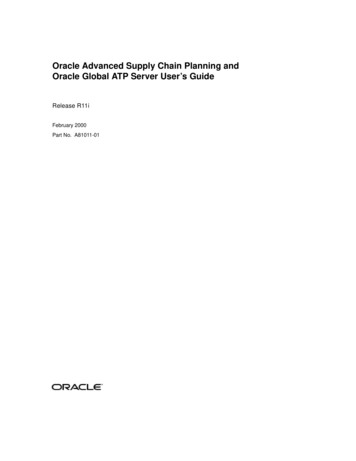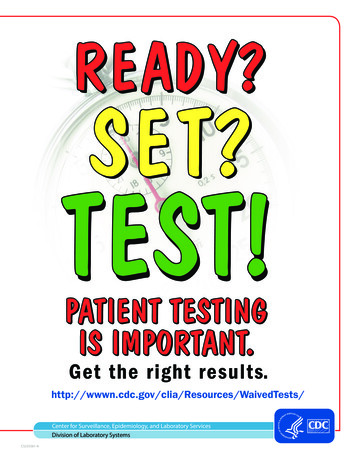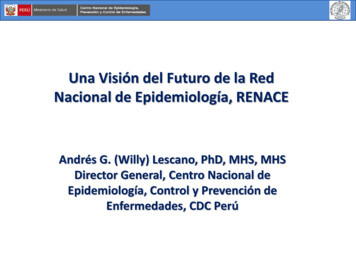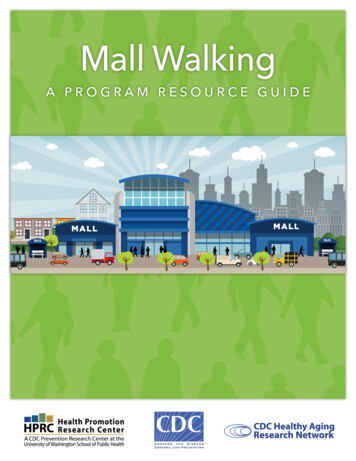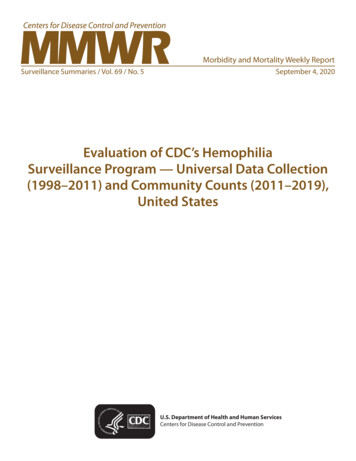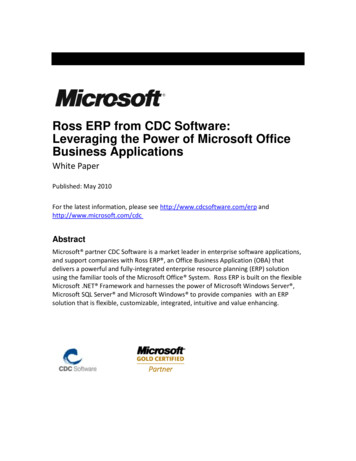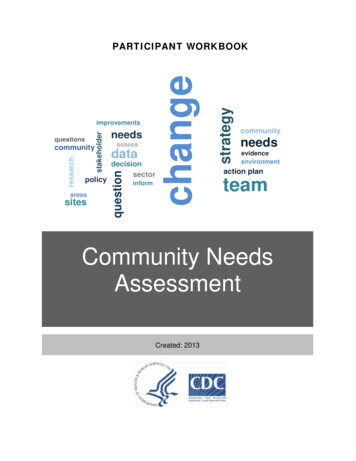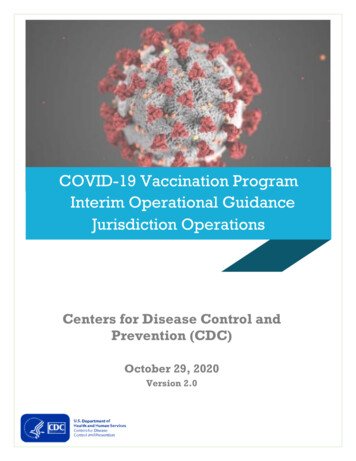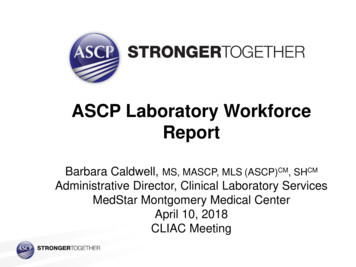
Transcription
ASCP Laboratory WorkforceReportBarbara Caldwell, MS, MASCP, MLS (ASCP)CM, SHCMAdministrative Director, Clinical Laboratory ServicesMedStar Montgomery Medical CenterApril 10, 2018CLIAC Meeting
Overview Introduction US Bureau of Labor Statistics Data ASCP 2015 Wage Survey ASCP 2016 Vacancy Survey
ASCP Organization Leadership
The ASCP Wage and Vacancy Surveys Biennial survey for the past 30 years demonstrates commitment toworkforce issues Survey results: Inform the government, academic institutions and otherorganizations about labor trends in the laboratory professionalworkforce Inform the general laboratory community to prepare for variousneeds for qualified laboratory professionals Useful as a vehicle to influence policy makers and also decisionmakers within institutions Promote solutions to ensure highly qualified laboratory professionalsenter and are maintained in the workforce Aid workforce planning in the changing health care environment andrapid evolution of technology Provide insight that workforce solutions are and will continue to bemulti-factorial
Data Action
U.S. Department of Bureau and Labor Statistics Occupational Employment Outlook (2014-2024): As of January 2018, overall unemployment rate 4.1% Overall employment projected to grow at approximately 7.0% Median annual wage for all workers 35, 540 Health Occupations Outlook (2014-2024): Projected to grow 19.0% 2.3 million new jobs Median annual wage 61, 710
U.S. Department of Bureau and Labor StatisticsMedical and Clinical Laboratory Technologists andTechnicians: Number of jobs, 2014 328,200 Job outlook 16% (much faster than average) Employment Change, 2014-24 52,100Phlebotomists Number of jobs, 2014 112,700 Job outlook 25% (much faster than average) Employment Change, 2014-24 28,1002
ASCP Workforce Data Occupational TitlesCytogenetic Technologist (CG)Cytotechnologist (CT)Histotechnician (HT)Histotechnologist (HTL)Laboratory Assistant (LA)LIS/PI/QAMedical Laboratory Technician(MLT)/Clinical Laboratory Technician (CLT)Medical Technologist (MT)/MedicalLaboratory Scientist (MLS)/ClinicalLaboratory Scientist (CLS)Molecular Biologist (MB)Pathologists’ Assistant (PA)Performance Improvement/QAPhlebotomist (PBT)Specialist in Blood Banking (SBB)39 certifications (including specialists andtechnologists) DepartmentsAnatomic Pathology (including non-MDprofessionals)Blood Bank (Immunohematology)Chemistry/ToxicologyCore LabCytogeneticsCytologyFlow Laboratory Information System/QualityAssurance/Performance ious DiseaseMolecular Biology/Molecular DiagnosticsMolecular PathologyPhlebotomyPoint-of-CareSend outsSpecimen ProcessingMultiple departments/All departments
2015 ASCP Wage Survey Conducted through collaboration between the ASCP’s Institute of Science,Technology, and Policy in Washington, DC, and Board of Certification(ASCP BOC) in Chicago, Illinois The Wage Survey Working Group - members work in the field of pathologyand laboratory medicine, reviewed the survey questions and critiqued thereport. Partner organizations were also invited to participate in completing thesurvey to get a larger scope of the current issues faced by the laboratoryworkforce. Asked individuals disqualified from this year’s wage survey of their currentstatus (i.e. clinical laboratory educator, retired, unemployed, working inlaboratory-related industry, working in a non-laboratory-related industry,working in a research laboratory) for future research studies.
Partner Organizations AABB (formerly the American Association of Blood Banks)American Association for Clinical Chemistry (AACC)American Medical Technologists (AMT)American Society for Clinical Laboratory Science (ASCLS)American Society of Cytopathology (ASC)American Society for Cytotechnology (ASCT)American Society for Microbiology (ASM)Clinical Laboratory Management Association (CLMA)National Society for Histotechnology (NSH)Philippine Association of Medical Technologists–USA(PAMET)
2015 ASCP Wage SurveySummary of Findings Participation: 16,661 respondents representing a 27.1% increase in participationcompared to the 2013 wage survey Demographic data collected indicate that 80.96% of the respondentsare female and 19.04% are male. The average age of laboratory personnel who responded to thesurvey is 43.95 years compared with 44.32 years in 2013. Of all the respondents, 21.60% are licensed by the state in whichthey currently work as a laboratory professional.
Mean & Median Ages of Laboratory Professionals Surveyed*
ASCP 2015 Wage Survey Results
ASCP 2013 vs 2015 Wage Survey Results
ASCP 2013 vs 2015 Wage Survey Results2
ASCP 2013 vs 2015 Wage Survey Results3
Wage Survey Comment Analysis
ASCP Wage 2015 Report Summary The average wage of laboratory professionals based on ageshows that salaries continue to increase considerably forevery age range except LA and PBT. There is a need for recruiting younger laboratoryprofessionals. Employee development such as training, continuingeducation and mentoring can prove beneficial in retainingstaff. Strategic focus on RECRUITMENT AND RETENTIONneeded! Wage Survey 2017 – publication date Fall 2018 in AJCP
2016-17 ASCP Vacancy SurveySummary of Findings Participation: 1,353 respondents (individuals who have hiring responsibilities)representing 51,586 employees Conducted through collaboration between ASCP’s Institute ofScience, Technology, & Policy in Washington, DC, the Evaluation,Measurement, and Assessment division and Board of Certification inChicago, IL. Vacancy Survey Working Group, whose members work in the field oflaboratory medicine, reviewed the survey questions and critiqued thereport. Published in the American Journal of Clinical Pathology (AJCP) inMarch 2018.
Partner Organizations2 AABB (formerly the American Association of Blood Banks) American Association for Clinical Chemistry American Society of Cytopathology American Society for Clinical Laboratory Science American Society for Microbiology Clinical Laboratory Management Association National Society for Histotechnology Philippine Association of Medical Technologists–USA St. Louis University
Laboratory Areas Surveyed Anatomic pathology (includingnon-MD professionals) Blood bank(immunohematology) Chemistry/toxicology Core laboratory Cytogenetics Cytology Flow cytometry Hematology/coagulation Histology Immunology LIS/QA/PI (new laboratory area surveyed) Microbiology/virology/infectiousdisease Molecular biology/diagnostics/molecular pathology Phlebotomy Point-of-care Send-outs Specimen processing
2016-17 ASCP Vacancy SurveySummary of Findings Across the nation, the overall vacancy rate was highest forLIS/QA/PI department (10.98%) and lowest for anatomic pathologydepartment (4.70%). LIS/QA/PI (11.68%) has the highest staff vacancy rate in the nationwhile anatomic pathology (5.00%) has the lowest staff vacancy rate. The highest supervisor vacancy rate occurred in the immunologydepartment (10.39%), and the lowest supervisor vacancy rateoccurred in the send-outs department (1.65%). LIS/QA/PI department has the highest overall percentage (28.30%)of employees anticipated to retire in the next 5 years.
2016-17 ASCP Vacancy SurveySummary of Findings2 Overall, survey results show that it takes less than 3 to 6months to fill positions in the departments surveyed. On average, hiring staff for most departments takes 3 to 6months, while hiring supervisors takes 3 months to a year. The Northeast region reported the highest overall vacancyrate compared with other regions (9.44%); the SouthCentral Atlantic had the lowest vacancy rate (6.31%).
2014 vs 2016-17 ASCP Overall Vacancy 35.936.6520142.000.00DepartmentsOverall vacancy rates (2014 vs. 2016).*Molecular Biology/Diagnostics/Molecular 010.8410.4212.004.70Overall Vacancy Rates (%)14.0013.0416.00
Vacancy Survey Overall Retirement Rates
Certification Requirement by Department
Shifts/Lay-offs Current data show that hard to fill shifts in 2014 shifts, alongwith evening shifts, are now once again difficult to fill. Data show that 95.70% (92.56% in 2014) of supervisorshave not laid off any lab professionals in the departments theysupervise within the past 6 months of participating in thissurvey. 88.23% (81.79% in 2014) do not anticipate laying off anylaboratory professionals in the department they supervise inthe next 6 months.
New Technologies The % of participants who indicated that new technologieshave caused changes to their staffing needs has remainedsteady (40.25% in 2014 vs 39.2% in 2016). Types of technologies causing the greatest changes tostaffing needs: Automation (55.10%)Molecular testing (54.92%)LIS (36.31%)Point-of-care (25.94%)Electronic medical records (19.14%)\ According to the respondents, automation has increased theneed for lower level staff to perform routine testing, leavingthe technologists to focus on verifying and running tests.
Hiring, Recruiting, and RetainingLaboratory PersonnelHIRINGRECRUITINGRETAININGBetter pay and/or benefitsat other laboratories(48.31%)Better pay and/or benefitsat other area laboratories(47.15%)Better pay and/or benefitsat other area laboratories(39.36%)Increasing competition forwell-trained personnel(41.74%)Increasing competition forwell-trained personnel(41.90%)Workload/stress (39.25%)Applicants do not possessnecessary certification,education, and/or skills toperform thework (38.36%)Applicants do not possessnecessary educationand skills to perform thework (37.26%)Limitedpotential for advancementand additionalcompensation (37.42%)
ASCP Vacancy 2016-17 Report Summary Data from this survey strongly suggest the crucial need in the supply ofqualified and certified laboratory personnel. Results from the qualitative analyses suggest that vacancies are beingfilled at a faster rate due to the increasing workload in the lab. Shortage in personnel trained in accredited lab program forcehiring managers to hire individuals with limited training to performlow- and at times, high complexity tests. Respondents also voiced concerns about competing with nursesfor an open position. Strategic recruitment of the next generation laboratory professionals musttake place in order to fulfill future demands. Targeting the STEM (science,technology, engineering and mathematics) pipeline and providing supportto non-traditional students and prospective students from rural areas.
Sources http://www. http://www.bls.gov/news.release/empsit.nr0.htm upation.htm#growth-by-detailedoccupation http://www.bls.gov/ooh/healthcare/home.htm nal-employment-projections-to-20241.htm https://www.bls.gov/ooh/healthcare/home.htm https://data.bls.gov/timeseries/LNS14000000 0.1093/ajcp/aqy005/4924356?guestAccessKey a70326c8-eca5-4040-a52ef5edfc398baf
workforce issues Survey results: Inform the government, academic institutions and other organizations about labor trends in the laboratory professional workforce Inform the general laboratory community to prepare for various needs for qualified laboratory professionals Useful
